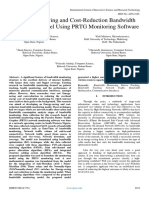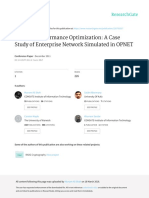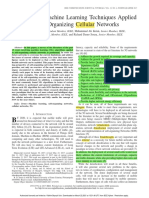Professional Documents
Culture Documents
A Study of Network Optimization Models For High-Performance Networks
Original Description:
Original Title
Copyright
Available Formats
Share this document
Did you find this document useful?
Is this content inappropriate?
Report this DocumentCopyright:
Available Formats
A Study of Network Optimization Models For High-Performance Networks
Copyright:
Available Formats
Volume 8, Issue 5, May – 2023 International Journal of Innovative Science and Research Technology
ISSN No:-2456-2165
A Study of Network Optimization Models for
High-Performance Networks
1 2 3
Oluwatobi Akinmerese, Oludele Awodele, Kofi Makinwa,
Computer Science, Babcock Computer Science, Babcock Microelectronics, Delft University of
University, Ilishan Remo, University, Ilishan Remo, Technology, Mekelweg,
Ogun State, Nigeria Ogun State, Nigeria Delft, The Netherlands
4 5
Shade Kuyoro, Folasade Adedeji,
Computer Science, Babcock University, Ilishan Remo, Computer Science, Babcock University, Ilishan Remo,
Ogun State, Nigeria Ogun State, Nigeria
Abstract:- An important feature of a bandwidth actuality, bandwidth optimization technologies improve the
optimization system is the adequate provision of internet effectiveness of the current network. Through the use of
services with high data rates and wide coverage. Low bandwidth optimization, data packets can be relayed. The
bandwidth causes poor internet speed, network number of internet-enabled end customers who use high-
downtime, constant network traffic congestion and performance service is always increasing, increasing the
network unavailability during peak and off-peak demands on HPN. Several investments have been made by
periods, to mention a few. Existing research on large organizations to provide a secure, accessible and
bandwidth optimization focused on bandwidth efficient internet connection to their users. Based on existing
allocation in creating different channels and traffic literatures, the current state of problems has been observed
isolation to Guarantee good Quality of Service (QoS). so far and outlined viz: Poor internet speed, Network
Despite several optimization techniques and bandwidth downtime, Constant traffic congestion, energy consumption
allocation algorithms of existing researchers, there is still of internet connectivity on the rise thereby increasing
reduced connectivity by which internet users are grossly overhead cost of management, network unavailability (peak
affected in spite of increased energy cost of network and off-peak periods). In lieu of this, there is a dire need for
devices and other infrastructure. One of the serious optimization of the network because failure to optimize
issues of optimization techniques is that of the problem network has led to business being affected, connectivity
of mixed-integer linear programming. Therefore, this being marred, increased cost and network unavailability
article gives a brief overview of a list of bandwidth issues to mention a few. However, none of the existing
optimization models deployed through previous literatures has solved bandwidth optimization technical
researchers, stating the optimal algorithms that work problems. Some of the bandwidth optimization models
with each of the models while formulating a new comprised Internet traffic data model, [14][25], client server
bandwidth optimization model that solves the problem model, [1], fluid flow model, [8] [22] and user-centric
of mixed-integer linear programming technique that was model, as considered by this article. This article evaluates
the approach adopted from existing works necessary for and analyzes existing bandwidth optimization models,
wireless networks. optimal algorithms that worked with each model, as well as
a new bandwidth optimization model that solves the
Keywords:- Bandwidth, Traffic Congestion, Bandwidth problem of previous optimization techniques. In achieving
Optimization, Bandwidth Allocation. this, four sections are presented. Section 1 discusses the
introduction, giving an overview of a list of bandwidth
I. INTRODUCTION optimization models deployed by existing research. Existing
bandwidth optimization models that were compatible with
The term "big data" was coined to describe the each of the models were covered in the section 2. Section 3
enormous amounts data applications of information science develops an optimal bandwidth optimization model that
and technology on a large scale have generated over time. solves the mixed-integer linear programming problem.
Big data is carried by High-Performing Networks (HPNs), Section 4 explains the proposed optimization model. Section
which have had the ability to connect to support numerous 5 describes the modified mathematical formula for the
separate processes. [70]. Industries increased their focus on optimization model. The conclusion is showcased in section
high-performance equipment clarifications for performance 6.
issues in various network tiers as bandwidth issues on the
operations network continued to develop [18]. When
describing a high-performance network, operator networks
are called "high performance." [4], [10]], [11], [7] & [6].
Studies have shown that it was not surprising that there is
great interest in high-performance networks [16]. In
IJISRT23MAY1631 www.ijisrt.com 2664
Volume 8, Issue 5, May – 2023 International Journal of Innovative Science and Research Technology
ISSN No:-2456-2165
II. II EXISTING BANDWIDTH OPTIMIZATION introduced as a partial solution [1]. Afterward, proxy caches
MODELS were used at the proxy level and showed success [2]. Later,
cooperative caches have been introduced such as Internet
Most researchers attest to the fact that having a clear caching protocol and Cache Array routing [3]. Mutual
understanding of what high-performance networks are and synergy was introduced as a solution as well [4]. CDN
are not made the best choice for business. The internet is technology is evolved to be one of the major border-side
one of the most crucial factors for bandwidth. A network solutions to the problem of bandwidth consumption. All the
that only consists of lower-cost providers, like many small previous solutions are application-level solutions. The idea
networks, is not high-performance. Currently, a "high- behind all these solutions is to transfer data once and
performance" network is included in the insurance coverage retrieve it several times. Such a technique requires that the
of about 16% of larger companies. This is anticipated to rise data is static and retrieved. Application-level solutions are
in the near future as these networks develop and grow. employed for real-time data, such as video streaming,
High-performance networks in computer science simply compression, and scalable video coding. Some other
refer to network equipment, infrastructure, and internet network-based solutions such as integrated services
services combined with facilities that are more capable of (interval), differentiated services (DiffServ), and resource
performing high-speed communications. By initializing reservation protocol (rsvp) used either bandwidth
every Internet Protocol (IP) address without a hitch, reservation or priority classes’ creation for the data [5],[6].
optimization also makes room for having high-quality
packet travel simultaneously from sender to receiver and Table 1 Scenarios
vice versa, such as audio or video files [13]. Scenario Mean Arrival Rate (Mbps)
Type 1 Type 2 Type 3 Type 4
Since the 20th century, people's network life has 1. 0.8 1.6 2.4 3.2
become more colorful due to the rapid advancement of 2. 3.2 2.4 1.6 0.8
computer technology, the popularity of high-performance 3. 1.6 1.6 1.6 1.6
computers, and the Internet traffic data model, which has
also undergone revolutionary changes due to cloud We use the fluid simulation in [8] that approximates
computing and big data technology [14]. The development the packet-level simulation. Lee et al. [13] proposed a
of Internet application technology also confronts significant bandwidth optimization algorithm in GPS servers with
difficulties due to the influence of such a large number of multiple service classes, in which we can minimize the total
network users and voluminous and complex traffic data [9]. bandwidth while different QoS requirements for each class
As information system performance and cluster architecture queue in a multiple queue system are satisfied. Since it is
improve, issues with network bandwidth and the processing difficult to analytically evaluate the performance for Internet
efficiency of traffic are created. How to make the system traffic with self-similar and long-range dependent
run with the highest efficiency and shortest completion time characteristics, the performance was evaluated mainly using
has become an issue that affects the overall function of the simulation. In particular, fluid simulation was performed
Internet. The lack of network bandwidth in the computer instead of packet-level simulation to reduce the complexity.
data processing center is the main factor leading to this The bandwidth optimization algorithm was based on an
problem [12],[23]. Therefore, in the big data communication exterior penalty function method, using the relation between
environment, it is crucial to figure out how to address the the allocated bandwidth vector and the performance
issue of how the massive data in the network obtained from fluid simulation. However, the bandwidth
communication channel takes up too much bandwidth, optimization using an exterior penalty function required a
leading to the traditional communication network channel long time to converge because it used many simulations to
bandwidth being unable to meet the needs of data obtain the direction vector and step size. In a fluid flow
communication, poor communication quality, low speed, model, The input rate of class i in a fluid flow model is
and so on [15]. constant in a unit time interval length, δ [22]. We take into
account an environment with four classes of queues, where
The long-distance cable capacity around the world is each input traffic has a length of 213 steps with resolution δ
much less in capacity than the amount of data transferred. = 0.1s. Table I shows the mean arrival rates of the four
Bandwidth limitation is a source of bottlenecks and delays different traffic classes in five different cases. The standard
over the network. As a consequence, QoS degradation due deviation of traffic amounts during a unit time interval with
to delay and latency is a serious issue. Really thanks to length δ = 0.1s is set to the mean amount during the same
content delivery networks (CDN) and peer-to-peer unit time, and the Hurst parameter is set to 0.85. (i = 1, . . . ,
technologies (P2P), the end-to-end or the client-server n), In order to satisfy the Quality of Service (QoS) needs for
model has been optimized to avoid passing the whole applications and to advance the transition to user-centric
network. Network and application-level solutions are network architectures, bandwidth allocation and
introduced to solve the problem of the delay of un-cached management are crucial [2]. Given that bandwidth is a
data. limited resource, artificial intelligence techniques are
progressively replacing traditional methods of bandwidth
The client-server architecture was utilized when the allocation. The development of wireless technology has
Internet first started. In such a model, the bandwidth was resulted in the emergence of applications, protocols, and
consumed very fast. Local caching on the client side was scenarios that have benefited human endeavors [20]. To
IJISRT23MAY1631 www.ijisrt.com 2665
Volume 8, Issue 5, May – 2023 International Journal of Innovative Science and Research Technology
ISSN No:-2456-2165
serve a variety of applications, services, and transmissions, This research suggests a brand-new algorithm to make
scalable and dependable communication networks are the most of available bandwidth for all text-based
required. Sensor networks, machine-to-machine applications. The algorithm is used for offline SMS in
communications, the Internet of Things, millimeter-wave mobile phones as well as real-time online text chatting. In
techniques, multiple input multiple output technology, and the core network, text is handled transparently without any
many more recent advancements have helped to increase the changes. The suggested approach employs the 'A-M'
effectiveness of communication and data transmission paradigm for compression. Depending on the context of the
through wireless networks [3]. The user-centric paradigm transferred data, using such an algorithm can save anywhere
based on Quality of Experience (QoE), which is decided by between 25% and 90% of the bandwidth. Other applications
QoS given by the network, is becoming more prevalent in such as email, web browsing, etc… will also gain from
mixed networking situations [5]. applying such an algorithm. Real-time text chatting and
mobile SMS apps were both demonstrated in this article.
III. OPTIMAL ALGORITHMS OF The technique relies on a pre-defined dictionary installed on
OPTIMIZATION MODELS the client side or in a cloud close to each client, with a
maximum size of 16 K bytes [1].
An algorithm for scheduling networks is called
weighted fair queueing (WFQ). According to [17], the We take into account a bandwidth optimization issue
researchers used high bandwidth utilization while in Generalized Processor Sharing servers with numerous
continuously submitting data to the users. In this class queues in order to reduce the overall bandwidth while
publication, the researchers discussed a number of still satisfying the QoS criteria for each class queue. In our
algorithmic techniques that could reduce the routing earlier paper [13], we used a simulation-based optimization
network's execution time, energy consumption, and time technique to achieve an optimum bandwidth vector because
delays. Peer-to-peer networks were provided with good it is challenging to quantitatively determine the
network services, a flexible network between users, and an performance, such as the delay distribution, with self-similar
absence of traffic regulations. To transfer data, it expanded input traffic in a GPS server. However, the previous
its bandwidth from source to destination. Additionally, it optimization algorithm requires rather a long simulation
reduced the amount of unavailable bandwidth. The time to solve the problem by using exterior penalty function
researchers employed techniques to maximize the methods. Without using complicated computations, we
bandwidth and transmission speed while transmitting the suggest a new bandwidth optimization approach based on
data in an equal amount of time. Since the bandwidth was bandwidth ratio adjustment. The time needed to determine
consumed in real-time, the article was unable to handle the the best bandwidth allocation for GPS servers is
problem of tracking the network by applying this significantly shorter in numerical findings [8] [22].
optimization technique.
In order to meet the Quality of Service (QoS) needs
An improved information application system is for applications and support the transition to user-centric
proposed by optimizing the fine integration method of fuzzy network architectures, bandwidth allocation and
fractional ordinary differential equations and combining management are crucial. Given that bandwidth is a limited
them with software-defined networking (SDN) to address resource, artificial intelligence techniques are progressively
the issues that the network bandwidth of previous replacing traditional methods of bandwidth allocation. The
information application systems cannot guarantee the Whale Optimization Algorithm (WOA) was examined in
quality of big data transmission, resulting in low this study to provide the best possible bandwidth allocation
transmission efficiency and slow data processing, etc. First, in wireless networks. WOA is a new swarm intelligence
the Pade approximation fractional-order fuzzy differential technique that imitates humpback whales' foraging
equation fine integration method is derived. The behavior. This study allocated the bandwidth to real-time
optimization formula for the adaptive selection of the users (RTUs) and nonreal-time users while reserving
weighted parameter N and the enlarged item number q is bandwidth for future users. The simulations were
then developed using the error analysis theory. An enhanced implemented in MATLAB and the results were discussed in
information application system is created when SDN is terms of connection probability with a focus on available
used, and the improved algorithm and system are found bandwidth and the numbers of RTUs on the network. The
using performance tests and example simulations. The findings showed that the suggested WOA technique
outcomes demonstrate that the upgraded method has higher effectively optimized the bandwidth allotted to customers
numerical accuracy and computing efficiency than the and demonstrated bandwidth management of the limited
improved algorithm. Additionally, compared to the previous quantity of bandwidth [2].
system, the enhanced port data merge rate and task
completion efficiency are much higher. It demonstrates that The speed at which data flows starts to slow down as
the information application system suggested in this study the volume of traffic gets close to the network's carrying
can more effectively address the issues of poor capacity. By default, new packets will be dropped if a queue
communication speed and insufficient bandwidth in buffer on an interface reaches capacity. Switches and routers
traditional systems, and it offers a fresh viewpoint for large can use Quality of Service (QoS) to queue and service
data bandwidth optimization [14]. higher-priority traffic before lower-priority traffic and to
remove lower-priority traffic in favour of higher-priority
IJISRT23MAY1631 www.ijisrt.com 2666
Volume 8, Issue 5, May – 2023 International Journal of Innovative Science and Research Technology
ISSN No:-2456-2165
traffic during times of congestion [24]. The employment of 2022]. Existing works of literature regarding bandwidth
various queuing techniques to manage which packets are monitoring and optimization systems were reviewed using
forwarded (bandwidth allocation) and which packets are the Preferred Reporting Items for Systematic Reviews and
dropped (Buffer space) was discussed in [21]. Meta-Analysis (PRISMA) method. The PRISMA approach
was chosen because it was more suited to comparing
IV. DATA FLOW-INTENSIVE MODEL bandwidth monitoring and optimization models and is most
broadly applicable across various study fields. The four
The model was implemented on a network operating stages of PRISMA are identification, screening, eligibility,
centre and lastly, the prototype developed was evaluated and inclusion.
using the OMNET++ simulation tool [Researcher’s model,
Fig 1 Data Flow Intensive Model
The main purpose of the review was to classify By existing works, The system's energy consumption,
systems that have been adopted in existing bandwidth E, was dependent on the device's energy consumption, P,
monitoring and optimization models and the types of which changed with time, t. If T was the duration for a
problems found. From the existing articles, the bandwidth particular period, then energy was provided by:
optimization issues discovered were categorized with
various metrics, approaches, and systems employed by
researchers. The articles revealed the flaws in the current
systems. Firstly, the new mathematical integration equations
based on time-series routing is deduced. A two discrete
As a result of the input data for the that are two
time-series of the input data for the bandwidth optimization
discrete time series: Anti-meridian (AM) and Prime-
based on the Anti-Meridian (AM) and Prime-Meridian (PM)
Meridian (PM) in this thesis study, a modified mathematical
formula is given as:
equation [5] was initially formulated from the existing
mathematical model for the integration of (AM)/(PM) Timer
relays)
IJISRT23MAY1631 www.ijisrt.com 2667
Volume 8, Issue 5, May – 2023 International Journal of Innovative Science and Research Technology
ISSN No:-2456-2165
GENERAL MATHEMATICAL analysis of existing NO-NC switches as a result of the triggering by am/pm
Formulae FOR AM/PM TIMER RELAY timer relay.
A new mathematical equation was in turn developed
which is known as ENERGY-SAVING AND COST
REDUCTION BANDWIDTH EQUATION(ESCRBE)
Take note that
V. MODIFIED MATHEMATICAL ENERGY-
SAVING AND COST REDUCTION
BANDWIDTH EQUATION
Where R (T) is any antiderivative of R(t) (that means In Wireless networks, the activities that consume most
R’(T) = R(t)). This is the fundamental theorem of network of the energy are network bandwidth transmission and
calculus. reception. The energy consumption for transmitting or
receiving data depends on the network traffic volume and
Among them the network traffic speed from the source to the destination.
Under such considerations, the expected energy to transmit
a PRTG analyzed monitoring metrics to the network
administrator is defined in Equation (6).
For Anti-Meridian (AM) Time
Where FUX is the utilized energy for data
transmission, M is the monitoring model for the Anti-
For Prime-Meridian (PM) Time Meridian (AM)/Prime-Meridian (PM) Timer relay, Famtr is
the consumed energy for transmitting or receiving data
Decision Variables according to the morning period between 12am till 12
U(T) = utilized energy, R(T) = Consumed energy noon, while Fpmtr is the consumed energy for transmitting or
receiving data according to the prime-time between 12noon
Objective Function till 12 midnight the following day. εno is the coefficient of
U1 (T1) + U2 (T2) = ʃ 0T1R1(t1) dt + ʃ 0T2R2(t2) dt energy consumed in the normally-open switch, εnc is the
coefficient of energy consumed in the normally-closed
switch, and eth is the number of active normally-
open/normally closed cisco wireless routers defined in
Equation (7).
= ½ [TR(t) + 0
= ½ R(t) T
= TR(t)/2
The expected energy to receive a PRTG analyzed
Where R(t) = Total Traffic Volume (sent and monitoring metrics for the anti-meridian time/prime-
received)/ Total traffic speed (sent and received) meridian time to the network administrator is calculated in
Equations (8) & (9)
R(t) = Total amount of energy utilized in network
devices FSX(M) = MFamtr (8)
As a result of the gaps registered and observed in the FSX(M) = MFpmtr (9)
formula for existing works as applied in (i) which are as
follows, Since a normal cisco wireless router ni only transmit
data to the network hosts via the network server, the
Existing formula concentrated on power consumption following equation can calculate its energy consumption:
of network devices while leaving out the energy
consumption rate of the wireless devices F(ni) = FUX(M) (10)
Existing formula also focused on AC power of the
network devices only while leaving out the DC source However, the utilized energy of a network host must
of power especially when there is power outage due to include the consumed energy of destination network
any form of circumstance bandwidth from host networks, AM/PM timer relay, and
The am/pm timer relay was not eventually integrated normally-open/normally-closed switches to the Energy-
because the previous mathematical model only applied saving and cost reduction monitoring model. Therefore, the
am/pm while leaving out the automatic switching of
IJISRT23MAY1631 www.ijisrt.com 2668
Volume 8, Issue 5, May – 2023 International Journal of Innovative Science and Research Technology
ISSN No:-2456-2165
energy consumption of a network host DIj is calculated as comparison with the new bandwidth optimization model
Equation (11). was presented with a new mathematical equation that solves
the integral problem of merging the am/pm timer relay.
F(DIj)=FSX(M)Oj+(Oj+1) MFWR+FUX(M) (11)
VI. CONCLUSION
where Oj is the number of Network Hosts in Server J,
And FWR Is the Total Energy Linkage For For One-Hour The EEBMOM was developed using bandwidth
Interval Of Am/Pm Timer Relay. Under The Above optimization techniques. These techniques had five methods
Considerations, The Residual Energy Of A Network which were hardware compression, deduplication, object
Host Ni Can Be Estimated By Equation (12). caching, traffic shaping, and rectifying the forward error.
Data collection for this research based on bandwidth
monitoring using the Paessler Router Traffic Grapher
(PRTG) network monitoring software was done at a
network operating centre in South-Western Nigeria. The
While The Energy Loss Of A Network Between The data collected comprised 8,673 records of bandwidth
Source (Isp) To Destination (Clients/Consumers) DIj Is monitored metrics such as Date/Time of bandwidth
Described In Equation (13). monitoring, network Traffic volume (of end-to-end
connectivity), network traffic speed (from source to
destination and vice-versa), network downtime, and
coverage. The model was formulated using bandwidth
During the initialization stage, the prtg monitoring optimization (BO) techniques while the data collected were
software is activated to monitor initial network hosts and coupled with three algorithms: FUE-sub-channel matching
gives the analysis based on the date/time, network traffic algorithm (FSMA), Joint sub-channel and power allocations
volume, network traffic speed, network downtime and algorithm (JSPA), and integrated structure cabling system
network coverage metrics based on the consumed energy. (ISCS) algorithm. The performance of the algorithms was
Once the prtg has monitored the network hosts, the am/pm evaluated based on four BO metrics: network bandwidth
timer relays will be triggered by the monitoring sensors of dropping, network bandwidth blocking, bandwidth
the prtg via the network administrator. Furthermore, the utilization and bandwidth consumption. The optimal
normally-open/normally closed switches are then triggered algorithm was used to formulate the optimization model
by the am/pm timer relays to switch-on active cisco wireless using the PRTG monitoring tool. A new mathematical
(border gateway) routers and switch off passive cisco equation was formulated from the model for the integration
wireless (border gateway) routers till whenever the network of Anti-Meridian (AM)/ Prime-Meridian (PM) Timer relays
bandwidth of the host network is about to clog up, then this and the Normally-Open (NO)/Normally-closed (NC)
process is vice-versa. This process is called the Energy- switches for energy-efficiency to design the EEBMOM. The
saving and cost reduction control model. (ESCRCM). EEBMOM was implemented by solving an optimization
problem using the mixed-integer programming optimization
The process of selecting network hosts to build an technique. The EEBMOM was tested and evaluated using
optimal network bandwidth algorithm by the by the prtg is the OMNET++ simulation software. (OSS).
described in the testing and evaluation stage.
REFERENCES
Other components used were Anti-Meridian/Prime-
Meridian (AM/PM) Timer relay which triggered the [1]. A. Mokhtar, A. Mansour and A. Fouad, “Bandwidth
Normally-open (NO), Normally-Closed (NC) switch. The Optimization for Real-Time Online and Mobile
NO-NC switch switched active routers on and made other Applications” Free Lancing, Nile Innovations, Cairo,
routers passive. Egypt
[2]. A. Tamuno-Omie, S. Orike and P. Elechi,
The bandwidth optimization model is presented on “Bandwidth Optimization of Wireless Networks
mixed-integer programming which was used to solve the Using Artificial Intelligence Technique” Department
mathematical equation involving the integration of the of Electrical Engineering, Rivers State University,
am/pm timer relay that triggers the no/nc switches both on Port Harcourt, Rivers State Nigeria
peak and off-peak modes (12 midnight till 12 noon and also [3]. C. Jiang, H. Zhang, Y. Ren, Z. Han, K. Chen, and L.
from 12 noon till 12 midnight the following day) from Hanzo, “Machine learning paradigms for next-
PRTG data collected for this study. generation wireless networks,” in IEEE Wireless
Communications, vol. 24, no. 2, pp. 98- 105, 2017.
The various algorithms developed for the bandwidth [4]. D. Oriato, S. Girdlestone and O. Mencer. “Dataflow
optimization technique vary in accuracy when applied to Computing in Extreme Performance Conditions”, in
other optimization models from the bandwidth usage [26]. Advances in Computers, Vol. 96, pp. 105-137,
Therefore, three (3) optimization algorithms namely: FUE- Elsevier (Science Publishing Co.), Amsterdam, New
sub-channel matching algorithm (FSMA), Joint sub-channel York, NY, USA 2015 doi:
and power allocations algorithm (JSPA) and integrated https://doi.org/10.1016/bs.adcom.2014.11.002.]
structure cabling system (ISCS) algorithms were applied in
IJISRT23MAY1631 www.ijisrt.com 2669
Volume 8, Issue 5, May – 2023 International Journal of Innovative Science and Research Technology
ISSN No:-2456-2165
[5]. F. Farid, S. Shahrestani, and C. Ruan, “Quality of [18]. SGRwin, “TOP ten benefits of network performance
service concerns in wireless and cellular networks,” management”, Santander (Cantabria) Madrid, 2019.
in Communications of the IBIMA, vol. 20, pp. 1 – Available [Online]: https://www.sgrwin.com/top-10-
15, 2013]. benefits-of-network-performance-management/
[6]. G. Varghese, “ Demultiplexing”, in Network [19]. S. Huang, P. Wei, and B. Hualaitu, “Bandwidth
Algorithms (An Interdisciplinary Approach to optimization of information application system under
Designing Fast Networked Devices), University of fine integral method of fuzzy fractional order
California, San Diego, 2007, ch. 8, pp. 182-196, doi: ordinary differential equations” School of
https://doi.org/10.1016/B978-012088477-3/50010-2]. Mathematics and Information Engineering,
[7]. I. Grigorik, “What every web developer should know Chongqing University of Education, Chongqing,
about Networking and browser performance”, 2013 China, July, 2020.
[8]. J. Lee, “Bandwidth Optimization Algorithm Based [20]. S. Orike and T. Alalibo, “Comparative analysis of
on Bandwidth Ratio Adjustment in Generalized computer network protocols in wireless
Processor Sharing Servers” IEEE Xplore, Korea communication technology,” in International Journal
Advanced Institute of Science and Technology Dan of Electronics Communication and Computer
Keun Sung Korea publication at: Engineering, vol. 10, no. 3, pp. 76 – 85, 2019.
https://www.researchgate.net/publication/224675686 [21]. T. Velmurugan, H. Chandra and S. Balaji,
Conference Paper · July 2006 DOI: https://doi.org ”Comparison of Queuing Disciplines for
10.1109/ICC.2006.254789 · Differentiated Services Using OPNET,” in Advances
[9]. J. Li, Y. Zhang, X. Chen and Y. Xiang, “Secure in Recent Technologies in Communication and
attribute-based data sharing for resource-limited users Computing, 2009. ARTCom, Vol. 9, no. 2, pp.744-
in cloud computing”, in Journal of Computer 746, 2009].
Security, Vol. 72 pp. 1–12, 2018. [22]. V. Paxson and F. Floyd, “Wide area traffic : The
[10]. J. Melnick, “Network devices explained”, Netwrix failure of poisson modeling,” in IEEE/ACM
Corporation, Texas, USA, 2022. Transactions on Networking, vol.3, no.3, pp.226-
[11]. J. Walrand and P. Varaiya, “Network services and 244, June, 1995.
Layered Architectures. High-Performance [23]. X. Wang, L. Yang, L. Kuang and X. Liu, “A tensor-
Communication on Networks”. 2nd Edition, ch. 2, pp. based bigdata-driven routing recommendation
39-102, 2000. Elsevier doi: https://doi.org/10.1016/ approach for heterogeneous networks”, IEEE
B978-0-08-050803-0.50007-1] Network, vol. 33, no. 1, pp. 64–69, 2019.
[12]. J. Wu, M. Dong, K. Ota, J. Li, “Big data analysis- [24]. X. Zhang and T. Wang, “Elastic and Reliable
based secure cluster management for optimized Bandwidth Reservation Based on Distributed Traffic
control plane in software defined networks”, IEEE Monitoring and Control”, in IEEE Transactions on
Transactions Network. Serv. Manage. Vol. 15 no. 1, Parallel and Distributed Systems Vol. 33, No.12,
pp. 27–38, 2018. pp. 4563 – 4580, August, 2022 doi:
[13]. M. Dirani and Z. Altman. "A cooperative https://doi.org/10.1109/TPDS.2022.3196840]
reinforcement learning approach for inter-cell [25]. Z. Ding, L. Li and Y. Hu, “A modified precise
interference coordination in OFDMA cellular integration method for transient dynamic analysis in
networks." In 8th Intl. Symposium on Modelling and structural systems with multiple damping models”, in
Optimization in Mobile, Ad Hoc and Wireless Mechanical System Signal Processing, ch. 98, pp.
Networks. IEEE, 2010. 613–633, 2018.
[14]. P. Li, J. Li, Z. Huang, C.Z. Gao, “Privacy-preserving
outsourced classification in cloud computing”, in
Journal of Cluster Computing. Vol. 21 no. 1, 277–
286, 2018.
[15]. R. Arya, S.C. Sharma, Energy optimization of energy
aware routing protocol and bandwidth assessment for
wireless sensor network, Int. J. Syst. Assurance Eng.
Manage. 9 (3) (2018) 612– 619.].
[16]. R. Grant and S. L. Oliver, “Networks and MPI for
cluster computing” in Topics in Parallel and
Distributed Computing (Introducing Concurrency in
Undergraduate Courses), ch. 6, pp. 117-153, 2015.
doi: https://doi.org/10.1016/B978-0-12-803899-
4.00006-7.
[17]. R. Reddy, V. Pavan, D. Reddy, R. Manikanta and I.
Chandra, “Bandwidth optimization using different
algorithm techniques in wireless sensor
networks”. International Journal of Advance
Research, Ideas and Innovations in Technology, Vol.
4, no. 6, pp. 187-191, 2018.
IJISRT23MAY1631 www.ijisrt.com 2670
You might also like
- Network Coding: Fundamentals and ApplicationsFrom EverandNetwork Coding: Fundamentals and ApplicationsMuriel MedardNo ratings yet
- An Energy-Saving and Cost-Reduction Bandwidth Monitoring Model Using PRTG Monitoring SoftwareDocument7 pagesAn Energy-Saving and Cost-Reduction Bandwidth Monitoring Model Using PRTG Monitoring SoftwareInternational Journal of Innovative Science and Research TechnologyNo ratings yet
- Cognitive Network Access Using Fuzzy Decision Making: IEEE Transactions On Wireless Communications August 2009Document14 pagesCognitive Network Access Using Fuzzy Decision Making: IEEE Transactions On Wireless Communications August 2009Muhammad ZeeshanNo ratings yet
- tmp627F TMPDocument19 pagestmp627F TMPFrontiersNo ratings yet
- Ieee Research Papers On Ad Hoc NetworksDocument4 pagesIeee Research Papers On Ad Hoc Networksyhclzxwgf100% (1)
- Call Admission Control Schemes in LTE Networks A SurveyDocument11 pagesCall Admission Control Schemes in LTE Networks A SurveySoundar rajanNo ratings yet
- Assignment: Topic: Two Page SummaryDocument3 pagesAssignment: Topic: Two Page Summarymuqaddas fatimaNo ratings yet
- Futureinternet 15 00392Document5 pagesFutureinternet 15 00392felipaoNo ratings yet
- Network Traffic Analysis A Case Study of ABU NetworkDocument8 pagesNetwork Traffic Analysis A Case Study of ABU NetworkAlexander DeckerNo ratings yet
- WiMAX Radio Network Planning and Analysi PDFDocument10 pagesWiMAX Radio Network Planning and Analysi PDFEze Alexander IkNo ratings yet
- Banking Network SystemDocument14 pagesBanking Network SystemDinomarshal PezumNo ratings yet
- Network Traffic Analysis: A Case Study of ABU Network: Intelligent Systems Engineering April 2013Document9 pagesNetwork Traffic Analysis: A Case Study of ABU Network: Intelligent Systems Engineering April 2013Mohamed HusseinNo ratings yet
- Router Research PaperDocument6 pagesRouter Research Paperh00sprt3100% (1)
- Network Performance Optimization A Case Study of Enterprise Network Simulated in OPNETDocument7 pagesNetwork Performance Optimization A Case Study of Enterprise Network Simulated in OPNETThomas James P. VillanuevaNo ratings yet
- Topological Planningand Designof Heterogeneous Mobile Networksin Dense AreasDocument7 pagesTopological Planningand Designof Heterogeneous Mobile Networksin Dense Areasfelix NizeyimanaNo ratings yet
- Research Paper On Ad Hoc NetworkDocument7 pagesResearch Paper On Ad Hoc Networkukldyebkf100% (1)
- Artificial Intelligence in Self Organizing NetworksDocument40 pagesArtificial Intelligence in Self Organizing NetworksKhurram AzizNo ratings yet
- Opnet Based Performance Evaluation of Wimax Network With Wimax Management Using Different QosDocument11 pagesOpnet Based Performance Evaluation of Wimax Network With Wimax Management Using Different QosMelankoli EfsanesiNo ratings yet
- Edge Intelligence: The Con Uence of Edge Computing and Artificial IntelligenceDocument25 pagesEdge Intelligence: The Con Uence of Edge Computing and Artificial IntelligencePraveen KumarNo ratings yet
- 14 Performance Analysis of Wired and Wireless LANDocument5 pages14 Performance Analysis of Wired and Wireless LANSigula Galuh0% (1)
- A Review of Recent Developments in NOMA & SCMA Schemes For 5G TechnologyDocument5 pagesA Review of Recent Developments in NOMA & SCMA Schemes For 5G TechnologyNguyễn HoàngNo ratings yet
- Performance Analysis of The Bus Topology Network For Effectual Data DistributionDocument8 pagesPerformance Analysis of The Bus Topology Network For Effectual Data DistributionIJEACS UKNo ratings yet
- Grid Computing 1Document11 pagesGrid Computing 1DannyNo ratings yet
- Design and Simulation of A Campus Network That Utilizes Redundant Links (A Case Study of Auchi Polytechnic, Auchi)Document15 pagesDesign and Simulation of A Campus Network That Utilizes Redundant Links (A Case Study of Auchi Polytechnic, Auchi)Binaebi DoubraNo ratings yet
- A Survey of Machine Learning Techniques Applied To SONDocument40 pagesA Survey of Machine Learning Techniques Applied To SONcerenNo ratings yet
- An Opportunistic Routing ProtocolDocument3 pagesAn Opportunistic Routing ProtocoldbpublicationsNo ratings yet
- Cognitive Network Access Using Fuzzy Decision Making: Nicola Baldo, Student Member, IEEE, and Michele Zorzi, Fellow, IEEEDocument13 pagesCognitive Network Access Using Fuzzy Decision Making: Nicola Baldo, Student Member, IEEE, and Michele Zorzi, Fellow, IEEERaja DineshNo ratings yet
- Efficient Bandwidth Recycling in Wireless Broadband NetworksDocument11 pagesEfficient Bandwidth Recycling in Wireless Broadband NetworksIJMERNo ratings yet
- Wireless Networks Throughput Enhancement Using Artificial IntelligenceDocument5 pagesWireless Networks Throughput Enhancement Using Artificial Intelligenceabs sidNo ratings yet
- Computer Networking Research PapersDocument8 pagesComputer Networking Research Papersfyrqkxfq100% (1)
- Prediction 5GDocument15 pagesPrediction 5GKátherin Huarhuachi EspinozaNo ratings yet
- Abapour, 2021Document10 pagesAbapour, 2021Faisal AliNo ratings yet
- Design and Simulation of A Banking Network System: American Journal of Engineering Research November 2015Document14 pagesDesign and Simulation of A Banking Network System: American Journal of Engineering Research November 2015Stéwàrt ChïkômôlâNo ratings yet
- Network Design 1Document22 pagesNetwork Design 1Ian Jasper FuriaNo ratings yet
- Design and Simulation of A Banking NetwoDocument13 pagesDesign and Simulation of A Banking NetwobelisaNo ratings yet
- Deep Learning Based Massive MIMO Beamforming For 5G Mobile NetworkDocument4 pagesDeep Learning Based Massive MIMO Beamforming For 5G Mobile NetworkVăn Hạo HàNo ratings yet
- Data Center Best Practices Ebook CH4 CO-110101-EnDocument7 pagesData Center Best Practices Ebook CH4 CO-110101-EnDavid Amado Vaca LanzaNo ratings yet
- Research Paper On Ad Hoc NetworkDocument7 pagesResearch Paper On Ad Hoc Networkh02rj3ek100% (1)
- Model-Driven Approach To Fading-Aware Wireless Network Planning Leveraging Multi-Objective Optimization and Deep LearningDocument23 pagesModel-Driven Approach To Fading-Aware Wireless Network Planning Leveraging Multi-Objective Optimization and Deep LearningGogyNo ratings yet
- Thesis Paper On Wireless Sensor NetworksDocument8 pagesThesis Paper On Wireless Sensor Networksihbjtphig100% (2)
- Research Paper On Bandwidth ManagementDocument7 pagesResearch Paper On Bandwidth Managementgw2xyzw9100% (1)
- Big Data Analytics Machine Learning and Artificial Intelligence in Next-Generation Wireless Networks PDFDocument11 pagesBig Data Analytics Machine Learning and Artificial Intelligence in Next-Generation Wireless Networks PDFChandanaNo ratings yet
- Ac 2012-4164: A Graduate Engineering Technology Course in Networks For The Industrial EnvironmentDocument9 pagesAc 2012-4164: A Graduate Engineering Technology Course in Networks For The Industrial Environmentboufakri abdelmounaimNo ratings yet
- Q190506110124 - An Investigation Study WiMAX Network Monitoring and Analysis Industrial Quality Management PDFDocument15 pagesQ190506110124 - An Investigation Study WiMAX Network Monitoring and Analysis Industrial Quality Management PDFHaris YaseenNo ratings yet
- IJASSNDocument1 pageIJASSNijassnjournalNo ratings yet
- 2018 A Survey of Caching Techniques in Cellular NetworksDocument38 pages2018 A Survey of Caching Techniques in Cellular NetworksFarzad MehrabiNo ratings yet
- Research Paper On RoutersDocument7 pagesResearch Paper On Routersafmbemfec100% (1)
- Design and Simulation of A Banking Network System: November 2015Document14 pagesDesign and Simulation of A Banking Network System: November 2015RosanaNo ratings yet
- Ad Hoc Wireless Network Research PapersDocument7 pagesAd Hoc Wireless Network Research Paperscam1hesa100% (1)
- Wireless Sensor Network Latest Research PapersDocument7 pagesWireless Sensor Network Latest Research Papersipkpzjbkf100% (1)
- Towards Enabling Network Slice Mobility To Support 6G SystemDocument15 pagesTowards Enabling Network Slice Mobility To Support 6G SystemMohamed YaCine LaidaniNo ratings yet
- Grid Computing: Isoc Member Briefing #11Document4 pagesGrid Computing: Isoc Member Briefing #11devapriyabtechNo ratings yet
- Bandwidth RecyclingDocument4 pagesBandwidth RecyclingMahesh BabuNo ratings yet
- Optimising Deep Learning Split Deployment For IoT Edge NetworksDocument6 pagesOptimising Deep Learning Split Deployment For IoT Edge NetworksmishaNo ratings yet
- Library Learning Activity: Abstract. Digital Library Is Shown As An Indispensable Element in DistantDocument9 pagesLibrary Learning Activity: Abstract. Digital Library Is Shown As An Indispensable Element in DistantIram Leopoldo Garcia AcostaNo ratings yet
- With Cover Page v2Document11 pagesWith Cover Page v2Cường Dương QuốcNo ratings yet
- LTE Radio Planning Using Atoll Radio Planning and Optimization SoftwareDocument6 pagesLTE Radio Planning Using Atoll Radio Planning and Optimization SoftwareLinder DuranNo ratings yet
- LTE Wireless Virtualization and Spectrum Management: Yasir Zaki, Liang Zhao, Carmelita Goerg and Andreas Timm-GielDocument6 pagesLTE Wireless Virtualization and Spectrum Management: Yasir Zaki, Liang Zhao, Carmelita Goerg and Andreas Timm-GielselfscorpionNo ratings yet
- International Journal of Advanced Smart Sensor Network Systems IJASSNDocument2 pagesInternational Journal of Advanced Smart Sensor Network Systems IJASSNijassnjournalNo ratings yet
- Application of Game Theory in Solving Urban Water Challenges in Ibadan-North Local Government Area, Oyo State, NigeriaDocument9 pagesApplication of Game Theory in Solving Urban Water Challenges in Ibadan-North Local Government Area, Oyo State, NigeriaInternational Journal of Innovative Science and Research TechnologyNo ratings yet
- Exploring the Post-Annealing Influence on Stannous Oxide Thin Films via Chemical Bath Deposition Technique: Unveiling Structural, Optical, and Electrical DynamicsDocument7 pagesExploring the Post-Annealing Influence on Stannous Oxide Thin Films via Chemical Bath Deposition Technique: Unveiling Structural, Optical, and Electrical DynamicsInternational Journal of Innovative Science and Research TechnologyNo ratings yet
- Osho Dynamic Meditation; Improved Stress Reduction in Farmer Determine by using Serum Cortisol and EEG (A Qualitative Study Review)Document8 pagesOsho Dynamic Meditation; Improved Stress Reduction in Farmer Determine by using Serum Cortisol and EEG (A Qualitative Study Review)International Journal of Innovative Science and Research TechnologyNo ratings yet
- Detection of Phishing WebsitesDocument6 pagesDetection of Phishing WebsitesInternational Journal of Innovative Science and Research TechnologyNo ratings yet
- A Study to Assess the Knowledge Regarding Teratogens Among the Husbands of Antenatal Mother Visiting Obstetrics and Gynecology OPD of Sharda Hospital, Greater Noida, UpDocument5 pagesA Study to Assess the Knowledge Regarding Teratogens Among the Husbands of Antenatal Mother Visiting Obstetrics and Gynecology OPD of Sharda Hospital, Greater Noida, UpInternational Journal of Innovative Science and Research TechnologyNo ratings yet
- The Impact of Music on Orchid plants Growth in Polyhouse EnvironmentsDocument5 pagesThe Impact of Music on Orchid plants Growth in Polyhouse EnvironmentsInternational Journal of Innovative Science and Research Technology100% (1)
- Sustainable Energy Consumption Analysis through Data Driven InsightsDocument16 pagesSustainable Energy Consumption Analysis through Data Driven InsightsInternational Journal of Innovative Science and Research TechnologyNo ratings yet
- Esophageal Melanoma - A Rare NeoplasmDocument3 pagesEsophageal Melanoma - A Rare NeoplasmInternational Journal of Innovative Science and Research TechnologyNo ratings yet
- Vertical Farming System Based on IoTDocument6 pagesVertical Farming System Based on IoTInternational Journal of Innovative Science and Research TechnologyNo ratings yet
- Mandibular Mass Revealing Vesicular Thyroid Carcinoma A Case ReportDocument5 pagesMandibular Mass Revealing Vesicular Thyroid Carcinoma A Case ReportInternational Journal of Innovative Science and Research TechnologyNo ratings yet
- Influence of Principals’ Promotion of Professional Development of Teachers on Learners’ Academic Performance in Kenya Certificate of Secondary Education in Kisii County, KenyaDocument13 pagesInfluence of Principals’ Promotion of Professional Development of Teachers on Learners’ Academic Performance in Kenya Certificate of Secondary Education in Kisii County, KenyaInternational Journal of Innovative Science and Research Technology100% (1)
- Consistent Robust Analytical Approach for Outlier Detection in Multivariate Data using Isolation Forest and Local Outlier FactorDocument5 pagesConsistent Robust Analytical Approach for Outlier Detection in Multivariate Data using Isolation Forest and Local Outlier FactorInternational Journal of Innovative Science and Research TechnologyNo ratings yet
- Realigning Curriculum to Simplify the Challenges of Multi-Graded Teaching in Government Schools of KarnatakaDocument5 pagesRealigning Curriculum to Simplify the Challenges of Multi-Graded Teaching in Government Schools of KarnatakaInternational Journal of Innovative Science and Research TechnologyNo ratings yet
- Review on Childhood Obesity: Discussing Effects of Gestational Age at Birth and Spotting Association of Postterm Birth with Childhood ObesityDocument10 pagesReview on Childhood Obesity: Discussing Effects of Gestational Age at Birth and Spotting Association of Postterm Birth with Childhood ObesityInternational Journal of Innovative Science and Research TechnologyNo ratings yet
- Entrepreneurial Creative Thinking and Venture Performance: Reviewing the Influence of Psychomotor Education on the Profitability of Small and Medium Scale Firms in Port Harcourt MetropolisDocument10 pagesEntrepreneurial Creative Thinking and Venture Performance: Reviewing the Influence of Psychomotor Education on the Profitability of Small and Medium Scale Firms in Port Harcourt MetropolisInternational Journal of Innovative Science and Research TechnologyNo ratings yet
- Designing Cost-Effective SMS based Irrigation System using GSM ModuleDocument8 pagesDesigning Cost-Effective SMS based Irrigation System using GSM ModuleInternational Journal of Innovative Science and Research TechnologyNo ratings yet
- Detection and Counting of Fake Currency & Genuine Currency Using Image ProcessingDocument6 pagesDetection and Counting of Fake Currency & Genuine Currency Using Image ProcessingInternational Journal of Innovative Science and Research Technology100% (9)
- Ambulance Booking SystemDocument7 pagesAmbulance Booking SystemInternational Journal of Innovative Science and Research TechnologyNo ratings yet
- Utilization of Waste Heat Emitted by the KilnDocument2 pagesUtilization of Waste Heat Emitted by the KilnInternational Journal of Innovative Science and Research TechnologyNo ratings yet
- Impact of Stress and Emotional Reactions due to the Covid-19 Pandemic in IndiaDocument6 pagesImpact of Stress and Emotional Reactions due to the Covid-19 Pandemic in IndiaInternational Journal of Innovative Science and Research TechnologyNo ratings yet
- An Overview of Lung CancerDocument6 pagesAn Overview of Lung CancerInternational Journal of Innovative Science and Research TechnologyNo ratings yet
- Digital Finance-Fintech and it’s Impact on Financial Inclusion in IndiaDocument10 pagesDigital Finance-Fintech and it’s Impact on Financial Inclusion in IndiaInternational Journal of Innovative Science and Research TechnologyNo ratings yet
- Auto Tix: Automated Bus Ticket SolutionDocument5 pagesAuto Tix: Automated Bus Ticket SolutionInternational Journal of Innovative Science and Research TechnologyNo ratings yet
- An Efficient Cloud-Powered Bidding MarketplaceDocument5 pagesAn Efficient Cloud-Powered Bidding MarketplaceInternational Journal of Innovative Science and Research TechnologyNo ratings yet
- Effect of Solid Waste Management on Socio-Economic Development of Urban Area: A Case of Kicukiro DistrictDocument13 pagesEffect of Solid Waste Management on Socio-Economic Development of Urban Area: A Case of Kicukiro DistrictInternational Journal of Innovative Science and Research TechnologyNo ratings yet
- Forensic Advantages and Disadvantages of Raman Spectroscopy Methods in Various Banknotes Analysis and The Observed Discordant ResultsDocument12 pagesForensic Advantages and Disadvantages of Raman Spectroscopy Methods in Various Banknotes Analysis and The Observed Discordant ResultsInternational Journal of Innovative Science and Research TechnologyNo ratings yet
- Comparative Evaluation of Action of RISA and Sodium Hypochlorite on the Surface Roughness of Heat Treated Single Files, Hyflex EDM and One Curve- An Atomic Force Microscopic StudyDocument5 pagesComparative Evaluation of Action of RISA and Sodium Hypochlorite on the Surface Roughness of Heat Treated Single Files, Hyflex EDM and One Curve- An Atomic Force Microscopic StudyInternational Journal of Innovative Science and Research TechnologyNo ratings yet
- Examining the Benefits and Drawbacks of the Sand Dam Construction in Cadadley RiverbedDocument8 pagesExamining the Benefits and Drawbacks of the Sand Dam Construction in Cadadley RiverbedInternational Journal of Innovative Science and Research TechnologyNo ratings yet
- Predictive Analytics for Motorcycle Theft Detection and RecoveryDocument5 pagesPredictive Analytics for Motorcycle Theft Detection and RecoveryInternational Journal of Innovative Science and Research TechnologyNo ratings yet
- Computer Vision Gestures Recognition System Using Centralized Cloud ServerDocument9 pagesComputer Vision Gestures Recognition System Using Centralized Cloud ServerInternational Journal of Innovative Science and Research TechnologyNo ratings yet
- FTTx Networks: Technology Implementation and OperationFrom EverandFTTx Networks: Technology Implementation and OperationRating: 5 out of 5 stars5/5 (1)
- CISSP Fast Track Master: CISSP Essentials for Exam Success - Exam Cram Notes: 1st Edition - 2024From EverandCISSP Fast Track Master: CISSP Essentials for Exam Success - Exam Cram Notes: 1st Edition - 2024No ratings yet
- The Windows Command Line Beginner's Guide: Second EditionFrom EverandThe Windows Command Line Beginner's Guide: Second EditionRating: 4 out of 5 stars4/5 (4)
- Open Radio Access Network (O-RAN) Systems Architecture and DesignFrom EverandOpen Radio Access Network (O-RAN) Systems Architecture and DesignNo ratings yet
- The Compete Ccna 200-301 Study Guide: Network Engineering EditionFrom EverandThe Compete Ccna 200-301 Study Guide: Network Engineering EditionRating: 5 out of 5 stars5/5 (4)
- Cybersecurity: The Beginner's Guide: A comprehensive guide to getting started in cybersecurityFrom EverandCybersecurity: The Beginner's Guide: A comprehensive guide to getting started in cybersecurityRating: 5 out of 5 stars5/5 (2)
- AWS Certified Solutions Architect Study Guide: Associate SAA-C02 ExamFrom EverandAWS Certified Solutions Architect Study Guide: Associate SAA-C02 ExamNo ratings yet
- Hacking: A Beginners Guide To Your First Computer Hack; Learn To Crack A Wireless Network, Basic Security Penetration Made Easy and Step By Step Kali LinuxFrom EverandHacking: A Beginners Guide To Your First Computer Hack; Learn To Crack A Wireless Network, Basic Security Penetration Made Easy and Step By Step Kali LinuxRating: 4.5 out of 5 stars4.5/5 (67)
- ITIL® 4 Create, Deliver and Support (CDS): Your companion to the ITIL 4 Managing Professional CDS certificationFrom EverandITIL® 4 Create, Deliver and Support (CDS): Your companion to the ITIL 4 Managing Professional CDS certificationRating: 5 out of 5 stars5/5 (2)
- Network+ Study Guide & Practice ExamsFrom EverandNetwork+ Study Guide & Practice ExamsRating: 4.5 out of 5 stars4.5/5 (5)
- Evaluation of Some Websites that Offer Remote Desktop Protocol (RDP) Services, Virtual Phone Numbers for SMS Reception and Virtual Debit/Credit CardsFrom EverandEvaluation of Some Websites that Offer Remote Desktop Protocol (RDP) Services, Virtual Phone Numbers for SMS Reception and Virtual Debit/Credit CardsNo ratings yet
- Evaluation of Some Websites that Offer Virtual Phone Numbers for SMS Reception and Websites to Obtain Virtual Debit/Credit Cards for Online Accounts VerificationsFrom EverandEvaluation of Some Websites that Offer Virtual Phone Numbers for SMS Reception and Websites to Obtain Virtual Debit/Credit Cards for Online Accounts VerificationsRating: 5 out of 5 stars5/5 (1)
- Networking Fundamentals: Develop the networking skills required to pass the Microsoft MTA Networking Fundamentals Exam 98-366From EverandNetworking Fundamentals: Develop the networking skills required to pass the Microsoft MTA Networking Fundamentals Exam 98-366No ratings yet
- Cybersecurity: A Simple Beginner’s Guide to Cybersecurity, Computer Networks and Protecting Oneself from Hacking in the Form of Phishing, Malware, Ransomware, and Social EngineeringFrom EverandCybersecurity: A Simple Beginner’s Guide to Cybersecurity, Computer Networks and Protecting Oneself from Hacking in the Form of Phishing, Malware, Ransomware, and Social EngineeringRating: 5 out of 5 stars5/5 (40)
- Computer Networking: The Complete Beginner's Guide to Learning the Basics of Network Security, Computer Architecture, Wireless Technology and Communications Systems (Including Cisco, CCENT, and CCNA)From EverandComputer Networking: The Complete Beginner's Guide to Learning the Basics of Network Security, Computer Architecture, Wireless Technology and Communications Systems (Including Cisco, CCENT, and CCNA)Rating: 4 out of 5 stars4/5 (4)
- ITIL® 4 Drive Stakeholder Value (DSV): Your companion to the ITIL 4 Managing Professional DSV certificationFrom EverandITIL® 4 Drive Stakeholder Value (DSV): Your companion to the ITIL 4 Managing Professional DSV certificationNo ratings yet
- Digital Evidence and Computer Crime: Forensic Science, Computers, and the InternetFrom EverandDigital Evidence and Computer Crime: Forensic Science, Computers, and the InternetRating: 4.5 out of 5 stars4.5/5 (3)
- AWS Certified Solutions Architect Study Guide: Associate SAA-C01 ExamFrom EverandAWS Certified Solutions Architect Study Guide: Associate SAA-C01 ExamRating: 4 out of 5 stars4/5 (1)























































































































